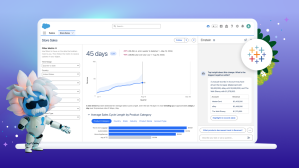How integration, automation, and APIs work together to get any organization’s hyperautomation in motion
From windmills to washing machines, people have always turned to technology to automatically complete manual work.
Things are no different in the digital age. The recently-published Mulesoft IT and Business Alignment Barometer revealed that 93% of organizations are either already using automation, or are planning automation initiatives to realize their strategic goals.
However, many organizations are just scratching the surface when it comes to automating their digital business. The real opportunity for change will come as automation scales across the entire company by re-using processes and deploying multiple, integrated technology capabilities – such as low-code platforms, machine learning, and robotic process automation (RPA).
These innovative technologies are part of an enterprise movement industry analysts are calling hyperautomation.
“Organizations increasingly want to automate anything that can be automated,” explained Rahul Pahuja, Director – Global MuleSoft Practice at Slalom, a MuleSoft partner. “Hyperautomation promises to deliver on that need by driving greater efficiencies, improve productivity, and reduce costs in everything from streamlined sales operations to accelerated customer case resolution.”
What’s new about hyperautomation technologies is that they are often self-serve, allowing non-IT workers to create automated solutions themselves. These capabilities make it easier for business technologists to unlock and integrate data from anywhere while IT manages, monitors, secures, and governs the resulting automations at scale.
Laying the foundation for hyperautomation success
While Robotic Process Automation (RPA) is an increasingly popular and easy way for teams to automate individual processes without needing specialized development skills, deploying and maintaining RPA solutions at scale has become more complex. Organizations can no longer automate processes in isolation; they need to be able to securely integrate, automate, and manage workflows across multiple silos of data and systems at scale.
Of course, this is easier said than done when data security and governance, an absence of technology and integration skills, and data silos remain a barrier to many automation initiatives according to the MuleSoft IT and Business Alignment Barometer.
To achieve hyperautomation success, organizations need to be able to bring together integration, API management, and automation technologies to connect all of their data and applications. By doing so, companies can begin to scale automation and increase the speed of work.
That’s why we were delighted to combine MuleSoft’s API and integration platform with Servicetrace’s leading RPA platform.
MuleSoft makes it easy to unlock and integrate data from anywhere, and to manage, monitor, secure and govern that data at scale. Now, we are also making it simple for business users to automate business processes and dramatically increase efficiency and speed — which enables hyperautomation. This makes it possible for companies to turn every data, automation, and application asset into reusable building blocks to compose digital-first experiences, faster.
“In a world where COVID still lingers on, the pressing need to transform makes the hunger for automation much higher,” said Paolo Malinverno, VP of Strategy and Innovation, MuleSoft. “Going forward, composability, achieved through targeted mixes of technologies such as API management, integration, RPA, process mining, AI / ML and more, will be the key factor for enterprises to gradually achieve a hyperautomated state at maximum speed.”
Enabling end-to end workflow automation
By taking a unified approach to integration, API management, and automation, companies will have a more resilient, secure, and flexible foundation to automate business processes in the future.
Such an approach will also enrich customer experiences, empowering organizations to deliver connected experiences from anywhere. For example, companies can scale customer service by automating embedded processes in chatbots to guide customers step-by-step to solve an issue. Or in an industry-specific context, lending organizations can leverage the power of RPA and cloud-based CRM to automate the loan approvals process.
These innovations couldn’t come at a better time, as pandemic-led customer demand has placed additional stress on already-overloaded teams.
John Kucera, Senior Vice President of Product Management, Salesforce, said, “Greater digital demand from customers has added new pressures for sales, customer service, commerce, and other business operations. Automation is now an imperative, as it helps companies create intelligent digital self service and automate tedious tasks, liberating employees to better serve customers.”
Getting hyperautomation in motion
Hyperautomation requires both IT and business teams to work closely together to deliver real business value. And, at a time when 95% of IT and engineering leaders say their organizations are prioritizing workflow automation, effective integration and API management will be critical to success.
What is clear is that hyperautomation is no longer a nice-to-have. Using technology to build a solid foundation is the best way to let any hyperautomation strategy take flight.
More information:
Read this article on how new research found a link between lower stress levels and business automation.



















